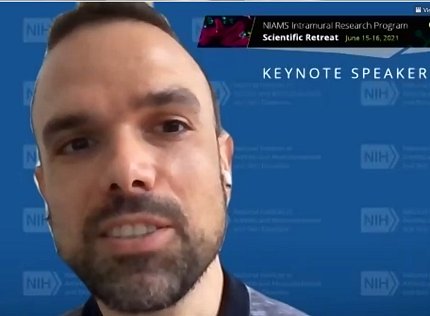Nature Medicine Editor Advises How to Counter Misinformation

The Covid-19 pandemic triggered a spread of misinformation and false claims about the disease. It also spurred fundamental changes in the way science is communicated.
In his keynote talk at a virtual retreat for the NIAMS Intramural Research Program, Dr. Joao Monteiro, editor of Nature Medicine, described how his journal adapted to the altered landscape of science communication. He then called upon scientists to help counter the spread of false information and explained how to do so.
“You don’t need to be working on public health or vaccines to be worried about misinformation, because it really affects everyone and it can start anywhere,” he said. “You need to be prepared for how to engage with it in a way that doesn’t make things worse.”
A rise in misleading and false information during health emergencies is not new. Monteiro noted that the tenor and general threads circulating today echo those from the 2014 Ebola outbreak. These include mischaracterizing the disease, casting blame on certain groups of people, touting unproven treatments and spreading conspiracy theories about the disease’s origins. What is striking this time around is the speed and volume of misinformation—and that it is fueled, in part, by easy access to legitimate research.
In January 2020, recognizing an impending global health crisis, scientific organizations committed to the rapid and open sharing of Covid-19-related information.
Nature Medicine joined more than 150 organizations that signed on, including other scientific publishers, research institutions, government agencies and pharmaceutical companies. Free access to peer-reviewed scientific information about Covid-19 skyrocketed. Monteiro referenced one estimate that more than 200,000 coronavirus-related papers were posted in 2020.
Add to that all the news stories, online content and social media posts, and it’s a formula for confusion.
“People have a lot of information to deal with,” said Monteiro. “They have lots of different sources…and navigating it when you are not a scientist can be extremely challenging.”

Photo: ADAPTED FROM TYPES, SOURCES AND CLAIMS OF COVID-19 MISINFORMATION, REUTERS INSTITUTE FOR THE STUDY OF JOURNALISM
That abundance of data and viewpoints plants the seeds for misinformation. Citing a 2020 study by Reuters Institute and the University of Oxford, Monteiro noted that 59 percent of misleading or false information about Covid-19 was reconfigured from “existing and often true information [that] is spun, twisted, recontextualized or reworked” in ways that could bias readers. The study labeled 38 percent of Covid-19 misinformation “fabricated” and 3 percent “satire/parody.”
Nature Medicine conducted its own analysis of misinformation on Twitter, Facebook and YouTube.
“In a single day in February 2020, we identified 3,506 tweets, 138 Facebook posts and 19 YouTube videos linking authentic research papers to unfounded claims about the SARS-CoV-2 pandemic,” reported Monteiro.
Recognizing that its content can easily be twisted into misinformation, the journal responded by rethinking its audience and its responsibility to readers. In the past, Nature Medicine primarily targeted the scientific community. Now, it views everyone as its audience, Monteiro said.
The journal added new features to better serve this broader audience.
For readers who lack a strong scientific background, the journal created its News Explainer format, which summarizes scientific findings in clear, jargon-free language.
For policymakers, it introduced the Policy Summary, which describes possible implications of new research. In addition, by publishing opinion pieces such as “It is not the time for science fiction,” the journal is using its editorial platform to fight misinformation.
Monteiro noted that, in the past, most experts advised against responding to false or misleading information to avoid amplifying its spread. Due to the explosion of Covid-19-related falsehoods, that thinking has shifted. Now, Monteiro said, the recommendation is to engage directly in “a head-on approach to break the chain that moves misinformation forward.”
Monteiro provided this advice for how to start:
- Speak up when you see or hear misinformation.
- Counter it with facts. “The more you can give the public information that is trustworthy and well sourced, the more you’ll be able to counterbalance the misinformation.”
- For falsehoods on social media, notify the relevant online platform. The World Health Organization provides instructions.
- Help teach non-scientists how science works.
- Convey that science is a self-correcting, iterative process in which conclusions evolve as new data become available. Acknowledge what is known and what isn’t.
- Think carefully about how you write your papers—your colleagues aren’t the only people who might read them. Present your work in a balanced, measured way.
- Recognize that “the same information can have very different downstream consequences depending on the way you report it.”
- Engage in science communication with the public as much as you can. Learn to talk about complex scientific concepts in simple ways. “People are not stupid. They can understand very complex concepts as long as you know how to explain them.”
- Be active on social media. Misinformation campaigns often start there. “I really encourage everyone to be involved on social media because it’s not going anywhere, and there’s a lot of important discussion happening there. If you’re not engaged, you’re losing out.”
False and misleading content impacts everyone and can come from the least-expected places, explained Monteiro.
“Tomorrow, it could be you out there and your research that’s being distorted with falsehoods,” he said. “So always speak up when you see misinformation in any context. And always, always, stand up for science.”
